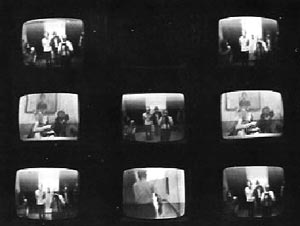[ index | VIDEO | 1969 ]
ira schneider
Ira Schneider’s work has been as central to the medium as that of the Vasulkas. He was present during the very earliest months of the movement, and seems to have been a founding member of most of the original groups. Together with Frank Gillette, he did one of the earliest multimonitor installations, Wipe Cycle, at the "Television as a Creative Medium" exhibition held at Howard Wise’s gallery in 1969. It was a nine-monitor piece, a console of monitors three high and three wide. Images shuttled from monitor to monitor, following four separate programmed cycles; there were live and delayed images of the gallery itself, broadcast images, prerecorded tapes, and gray “light” pulses.

This mix of images, which Schneider calls "information collage", has remained central to his work. In the spring of 1974, he did an installation at both the Everson Museum and The Kitchen called Manhattan Is an Island. Twenty-four monitors were arranged in the shape of Manhattan Island. The outside ring of monitors showed tapes of images of the island from boats; bus, land, architecture, and people tapes were all played on monitors in a logical part of the "island". The monitors were arranged at different heights, following the topography of the island. One monitor, facing up, displayed tape taken from a helicopter. Viewers could move in amongst the monitors, seeing specific bits and views of cityscape, or stand outside and watch the whole island hum along. The tapes from this piece have been edited down into a single tape one can watch on a single monitor.
Schneider says he tries to establish conditions with the information he provides, and so "guide not push" an audience along a route of perception. His latest tape, Bits, Chunks, and Pieces, does precisely that. So far, it is a black-and-white fifty-four minute "video album". It is very clearly and elegantly taped and moves the viewer along through different kinds of American landscape. One goes from "Santa Fe Fiesta" to "Tex-Mex" to "Rock 1", zooming along looking out a car window, stopping to see an eightyfive- foot doll named Zozobra explode in fireworks at the fiesta. Toward the end, the pace quickens, one becomes aware that the sound doesn't necessarily match the image, and certain sequences are repeated over and over (one remembers especially a line of cows swinging along the side of a road while "Put on Your High-Heeled Sneakers" blares on the car radio). Schneider stresses the nonnarrative nature of his album; he wants each viewer to figure out the information by himself.
- Johanna Branson Gill: VIDEO: STATE OF THE ART, 1976
[ index | 1969 ]